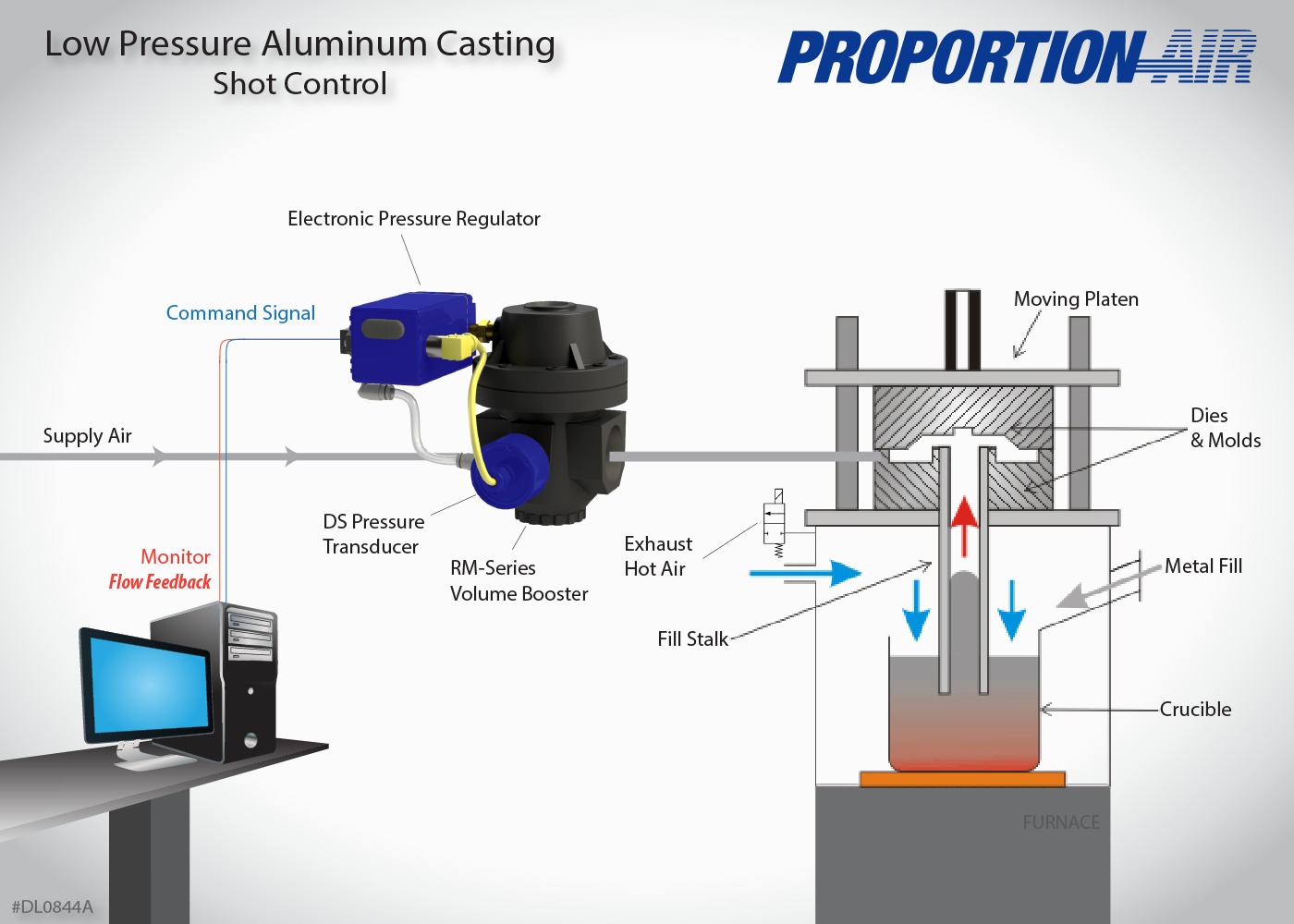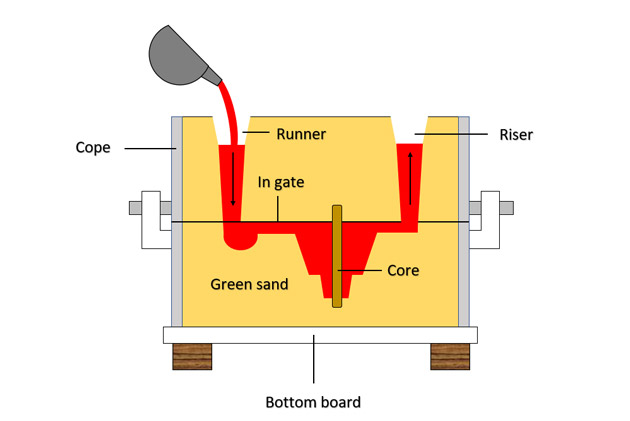Just How Aluminum Foundry Adds to Developments in Aerospace Engineering
Aluminum shops are indispensable to innovations in aerospace design. They generate lightweight, high-strength elements that are important for modern airplane. With advanced spreading methods, these foundries develop complex geometries that enhance structural honesty. Furthermore, the development of remarkable Aluminum alloys supports the sector's concentrate on gas efficiency and sustainability. Challenges continue to be in the manufacturing process. Recognizing these aspects discloses the extensive influence of Aluminum on aeronautics's future.
The Significance of Lightweight Products in Aerospace Layout
As the aerospace sector continues to evolve, the significance of light-weight products ends up being progressively obvious. The demand for effectiveness and sustainability drives designers to prioritize the usage of products that decrease general weight without endangering structural stability. Light-weight materials, especially Aluminum, play an essential duty in enhancing fuel performance, improving haul capability, and increasing the total performance of aircraft.
The assimilation of these materials allows for cutting-edge styles, allowing suppliers to develop more aerodynamic shapes that can endure severe problems. The decrease in weight not only reduces functional expenses however additionally adds to a lowered ecological footprint, aligning with international efforts toward sustainability in aeronautics.
Advanced Spreading Techniques in Aluminum Foundries
Advanced casting techniques in Aluminum foundries play an essential role in aerospace design by enabling the production of lightweight and precise elements. Innovations in mold and mildew layout and accuracy spreading procedures are crucial in accomplishing perfect performance and architectural integrity. Additionally, the development of lightweight alloys boosts the general efficiency and effectiveness of aerospace applications.
Ingenious Mold Style
Ingenious mold style plays a vital function in the effectiveness and effectiveness of Aluminum foundries, particularly within the aerospace market. By leveraging sophisticated products and strategies, modern mold and mildews can be engineered to stand up to high temperature levels and stress, ensuring peak efficiency throughout the spreading process. These layouts frequently incorporate intricate geometries that permit the production of light-weight yet structurally sound parts, crucial for aerospace applications. In addition, the use of computer-aided design (CAD) software program assists in precise modeling, making it possible for factories to simulate and improve mold layouts prior to physical manufacturing begins. This not just enhances the high quality of cast parts but additionally reduces waste and lead times, leading to considerable cost financial savings. On the whole, cutting-edge mold and mildew design is a foundation of progress in Aluminum Foundry modern technology for aerospace design.
Precision Casting Processes
The efficiency of ingenious mold styles flawlessly integrates with accuracy spreading procedures, which are important for producing premium Aluminum parts in aerospace engineering. These processes, including sand casting, pass away casting, and financial investment casting, ensure the production of complicated geometries with tight resistances. Advanced strategies like vacuum cleaner casting and stress pass away casting enhance the honesty and surface coating of the end products. Accuracy casting reduces material waste while taking full advantage of the mechanical homes of Aluminum, crucial for aerospace applications. On top of that, using real-time monitoring and progressed simulation tools throughout the casting procedure enables immediate changes, bring about enhanced high quality control. Jointly, these precision spreading processes setting Aluminum foundries at the leading edge of aerospace innovation, sustaining the industry's demand for dependability and performance.
Lightweight Alloy Development
As aerospace engineers seek to boost fuel performance and efficiency, lightweight alloy growth comes to be a necessary emphasis in Aluminum foundries. These factories use innovative spreading methods to produce alloys that supply superior strength-to-weight ratios. Advancements in alloy composition, including the incorporation of aspects like lithium and magnesium, enable the manufacturing of materials that withstand severe problems while lowering general aircraft weight. Strategies such as die casting and financial investment spreading assist in the accuracy manufacturing of complex shapes, which are vital for aerospace applications. Additionally, ongoing research study intends to optimize these alloys for enhanced mechanical homes and increased sturdiness. By prioritizing lightweight alloy development, Aluminum shops significantly contribute to the evolution of aerospace design, leading the way for extra effective and sustainable aircraft layouts.

Enhancing Structural Honesty With Aluminum Elements
Aluminum elements offer considerable benefits in enhancing structural stability within aerospace design. Their light-weight nature contributes to overall effectiveness while maintaining stamina, which is important for airplane performance. Additionally, the stress and anxiety resistance properties of Aluminum assistance ensure the durability and integrity of aerospace structures under numerous operational problems.
Light-weight Material Benefits
While typical materials frequently compromise weight for strength, using Aluminum components in aerospace design provides significant advantages in architectural integrity. Aluminum's lightweight nature adds to general style effectiveness, allowing for even more streamlined aircraft that eat less fuel, therefore improving sustainability. The material's exceptional strength-to-weight ratio warranties that components preserve durability without adding unneeded mass. This top quality cultivates enhanced performance and dexterity in flight, in addition to maximized haul abilities. In addition, Aluminum's resistance to corrosion extends the life expectancy of aerospace structures, decreasing upkeep prices and improving safety. As makers significantly adopt Aluminum alloys, the aerospace industry experiences a transformative shift in the direction of extra reliable and reliable design services that focus on both efficiency and ecological obligation.
Anxiety Resistance Qualities
Various products have special residential properties, Aluminum's exceptional anxiety resistance stands out as a vital aspect in enhancing the structural stability of aerospace parts. This resistance plays a critical duty in making sure that aircraft can hold up against different operational tensions, including fatigue, impact, and environmental conditions. Aluminum alloys, especially crafted for aerospace applications, exhibit high tensile strength while maintaining lightweight characteristics, making it possible for engineers to design much more reliable structures - Aluminum Foundry. In addition, the ability of Aluminum to endure cyclic loading without considerable contortion contributes to the longevity and integrity of aerospace components. As improvements continue in Aluminum Foundry techniques, the growth of stress-resistant Aluminum components promises further renovations in efficiency, safety, and effectiveness across the aerospace market, solidifying Aluminum's role as a preferred product in modern-day design
Gas Effectiveness Improvements Driven by Aluminum Innovations
As the aerospace market seeks to improve gas efficiency, ingenious uses Aluminum have actually become a necessary solution. Aluminum's lightweight nature notably decreases airplane weight, permitting lower fuel usage during flight. This reduction in weight is vital, as also little reductions can result in significant renovations in general fuel economy.
Advanced Aluminum alloys, made for boosted stamina and durability, make it possible for manufacturers to create components that keep structural honesty while minimizing mass - Aluminum Foundry. In addition, the integration of Aluminum in airframes and engine components helps with enhanced aerodynamics, adding to reduced drag and boosted efficiency
The adoption of Aluminum in aerospace not only meets the demand for fuel-efficient design yet additionally lines up with regulatory pressures for reduced discharges. As these technologies proceed to develop, they play a considerable role in setting brand-new criteria for fuel performance, guaranteeing that the aerospace market can fulfill growing ecological and financial obstacles.

The Role of Aluminum in Sustainable Air Travel Practices
The increasing emphasis on sustainable aviation practices has placed Aluminum as a vital product in the quest for greener aircraft style. Recognized for its lightweight residential or commercial properties, Aluminum substantially decreases airplane weight, resulting in reduced gas intake and discharges. Its recyclability even more improves its sustainability profile, as Aluminum can be recycled forever without loss of top quality. This particular supports a circular economic climate within the air travel field, lessening waste and resource depletion.
Furthermore, improvements in Aluminum alloys have improved their stamina and rust resistance, permitting longer life span and decreased upkeep requirements. These technologies facilitate the advancement of much more reliable aircraft structures, adding to general sustainability efforts. Additionally, Aluminum's thermal conductivity plays an important role in energy-efficient layouts, enhancing systems such as heat exchangers. Jointly, these characteristics underscore Aluminum's critical duty in this website advancing lasting aeronautics, straightening with worldwide efforts targeted at reducing the ecological impact of air traveling.
Challenges Encountered by Aluminum Foundries in Aerospace Manufacturing
While Aluminum factories play a crucial function in aerospace manufacturing, they encounter considerable obstacles that can influence production performance and high quality. One major challenge is the stringent high quality control requirements called for in the aerospace industry. Any issue can compromise security and efficiency, demanding rigorous examination processes that prolong manufacturing timelines. Additionally, factories frequently compete with changing Look At This resources prices, which can influence pricing and earnings. The intricacy of Aluminum alloys utilized in aerospace applications additional complicates the production process, as precise formulations are important for achieving desired mechanical homes. In addition, skilled labor scarcities hinder the capability to maintain high-quality manufacturing degrees. Ultimately, environmental regulations enforce constraints on discharges and waste administration, requiring shops to buy sustainable methods, which can be cost-prohibitive. These factors collectively develop a landscape where Aluminum factories must continually adapt to fulfill the advancing needs of aerospace manufacturing while ensuring safety and conformity.
Future Fads in Aluminum Applications for Aerospace Design
With improvements in innovation and enhancing needs for efficiency, the future of Aluminum applications in aerospace design is poised for significant makeover. The assimilation of cutting-edge Aluminum alloys and compounds is expected to enhance strength-to-weight ratios, bring about even more fuel-efficient aircraft layouts. Additionally, developments in additive manufacturing strategies will allow for the production of complex Aluminum frameworks that were previously difficult, enhancing efficiency and lowering waste.

Lasting methods will play a necessary function, with a growing focus on recycling Aluminum to decrease ecological influence. The aerospace sector is likely to embrace smarter making procedures, such as automation and expert system, ensuring better and accuracy in Aluminum parts. Furthermore, partnerships in between Aluminum shops and aerospace firms will foster r & d, paving the way for brand-new applications that meet the rigid requirements of modern aerospace engineering - Aluminum Foundry. In general, the future looks guaranteeing for Aluminum's role in shaping the skies
Regularly Asked Inquiries
What Are the Environmental Impacts of Aluminum Manufacturing in Aerospace?
The ecological influences of Aluminum production in aerospace include considerable energy consumption, greenhouse gas emissions, and environment interruption. Furthermore, mining processes can lead to dirt deterioration and water contamination, increasing concerns about sustainability and eco-friendly balance.
Just How Does Aluminum Compare to Other Products in Aerospace Applications?
Aluminum uses a special combination of lightweight buildings, deterioration resistance, and cost-effectiveness contrasted to various other products. Its high strength-to-weight ratio makes it especially helpful for aerospace applications, boosting gas performance and general performance in aircraft design.
What Qualifications Do Aluminum Foundry Employees Requirement for Aerospace Projects?
Aluminum Foundry workers call for specialized training in metallurgy and spreading methods, together with knowledge of aerospace sector criteria. Certifications in quality control and safety procedures are additionally important to guarantee conformity with content rigid aerospace job requirements.
Are There Any Safety And Security Problems With Utilizing Aluminum in Aerospace Engineering?
Safety and security problems concerning Aluminum in aerospace engineering consist of sensitivity to rust, fatigue, and stress and anxiety fractures. Correct therapy and alloy choice are important to minimize these dangers, guaranteeing structural honesty and overall safety and security in aerospace applications.
Exactly How Does Aluminum Recycling Benefit the Aerospace Sector?
Aluminum reusing significantly profits the aerospace sector by lowering material prices, lessening environmental effect, and saving energy. This lasting method enhances the market's effectiveness while advertising using lightweight, high-performance elements in aircraft manufacturing.
Advanced casting techniques in Aluminum foundries play a critical role in aerospace engineering by enabling the production of lightweight and exact elements. Innovative mold layout plays an essential role in the efficiency and effectiveness of Aluminum foundries, particularly within the aerospace field. As aerospace designers look for to improve fuel effectiveness and performance, lightweight alloy development becomes a vital emphasis in Aluminum shops. Aluminum alloys, specifically engineered for aerospace applications, show high tensile toughness while keeping lightweight characteristics, making it possible for designers to make much more reliable frameworks. Partnerships in between Aluminum factories and aerospace companies will certainly cultivate research study and development, leading the way for brand-new applications that satisfy the stringent needs of modern-day aerospace engineering.